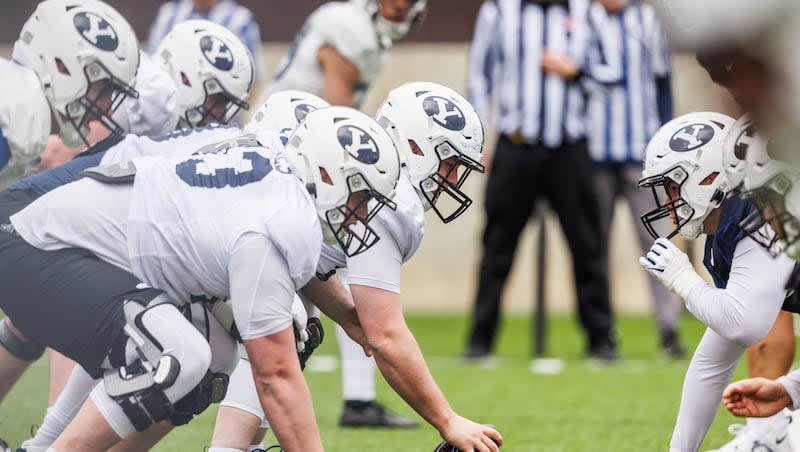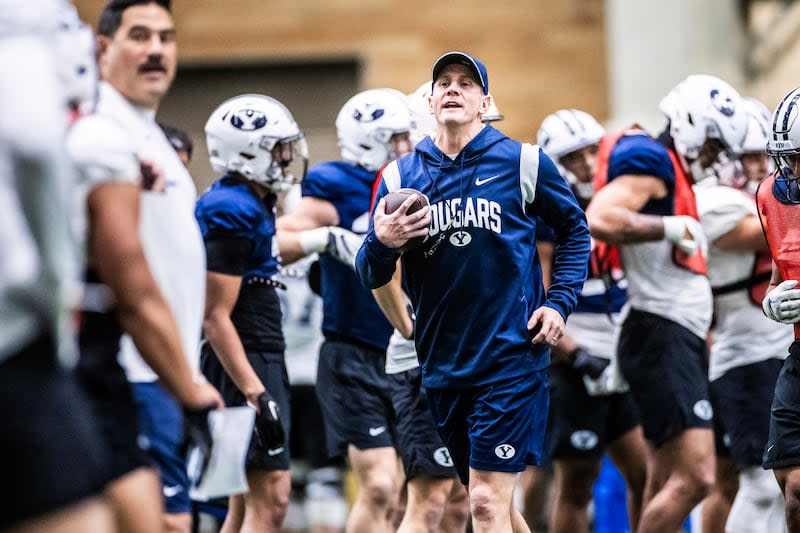BYU spring football concludes with emphasis on tweaking details, strengthening culture

One could say BYU learned a lot of lessons during its foray into the Big 12 this past year.
A big lesson in the losses to Oklahoma and Oklahoma State is how important small, seemingly simple things can be the difference between wins and losses.
That pick-six against Oklahoma while knocking on the goal line in LaVell Edwards Stadium was a backbreaker and pivotal in a loss that could have been the difference in getting to a bowl game. You could pick a number of plays, break down the execution, the decisions and the play calls that, if different, could have produced a different outcome.
“It’s a conscious effort, something you have to work on all the time. Once everyone has bought in, the trajectory can go really high, even in the middle of a season, even within a game. We are hoping to hit that sweet spot so we can face any type of adversity.”
BYU coach Kalani Sitake
NBA legend Kareem Abdul-Jabbar once said, “I try to do the right thing at the right time. They may just be little things, but usually they make the difference between winning and losing.”
This spring, BYU worked on small things they hope will lead to big things — at the least, more consistency.
Part of that is putting some new eyeballs on details, thus hiring TJ Woods for Aaron Roderick’s offensive line and run game, and former NFL tight ends coach Kevin Gilbride to work with BYU’s tight end corps.
This is also the case for adding consultants Chad Kauha’aha’a (UCLA, USC, Utah, Wisconsin, Oregon State, Boise State, Utah State, UNLV, Weber State) and Gary Andersen (Utah, Southern Utah, Utah State, Oregon State, Wisconsin).
It could also be said of the shakeup and additions to BYU’s strength and conditioning staff.
One BYU football coach said earlier this week the spirit and enthusiasm among coaches and players has been healthy and strong, as good as he’s seen since he’s been in the program.
Losing not only brings humility, but learning.
This spring, BYU is doing a lot of learning, trying to perfect the little things.
Head coach Kalani Sitake told 365 Sports in Texas this past week everything in the program is being evaluated. “We were a few plays from having a different result in several games. Of course everyone can say that, but it’s true.”
Sitake said he’ll continue leaning on the things that make the difference, like culture, but will focus on the little things.
On the topic of fitting transfer portal players into a roster, Sitake said this new challenge is something that coaches need to constantly work on and that the chemistry has to be developed naturally as a team.
“You need guys who are bought in and are positive,” Sitake said of former Baylor QB Gerry Bohanon, who came in this winter. Sitake said Bohanon’s positive attitude is a plus
“You can’t force it. Culture takes time. You can’t force it, even when you have attrition with guys graduating and moving on, guys you retain and are developing. Developing that stuff matters, but they also form a new identity even though they’re new to a team, even if you line up everything, they still have to all buy in.
“It’s a conscious effort, something you have to work on all the time. Once everyone has bought in, the trajectory can go really high, even in the middle of a season, even within a game. We are hoping to hit that sweet spot so we can face any type of adversity.”
In a place and society where there’s not a lot of patience, Sitake said football needs patience and hard work to make culture develop properly. That’s his aim.
This past week, pass game coordinator Fesi Sitake, who works with the receivers, said the amount of receivers with experience who return allows him to focus on the little things with technique and routes.
I caught up with #BYU TE @ryner_swanson after spring ball practice last Friday.
Get to know Ryner a little better, and why he came to BYU.
Find out why OC Aaron Roderick told him not to redshirt this year and how he's making an impact already.
⬇️#BYUFootball #ESPN960… pic.twitter.com/K262LWM7OP— Ronald Lee Weaver III (@ronaldweaverlll) March 13, 2024
“It enables me to focus on all the nuances. Last year, although they were experienced transfer receivers in Darius Lassiter and Keelan Marion, our playbook was still new. So now they’re experienced, it enables us to crystalize things.”
Fesi said it allows him to draw more attention to the finer points of playing in the offense, what technique to use, how to fit in the splits they need, and to be more deliberate in alignment instead of just “crossing our fingers” and hoping the play works.
“I can feel that these guys have taken a huge jump. I can line up anywhere and I’m confident they know what to do.”
In BYU’s running back room, coach Harvey Unga said the same thing, that making all of his players usable on all plays instead of being specialists in personnel groups allows the offense to be less predictable.
So, if there’s just one little thing to be taken from spring practices, which ended on Saturday, it could be the increased versatility of backs and receivers in being used in a myriad of formations instead of position groups for specific plays.
It’s a small tweak, but it could be the difference in consistency and performance in a few plays during a game or two.
This was a big part of BYU’s spring, now done.


